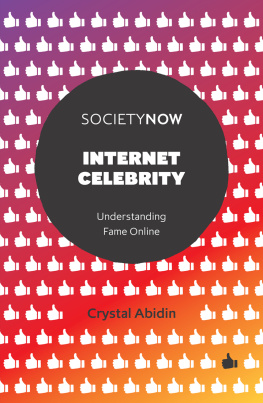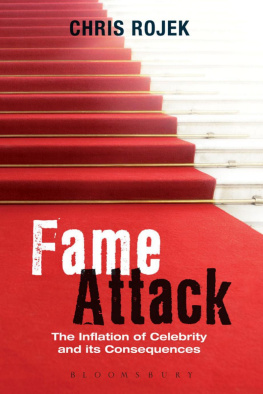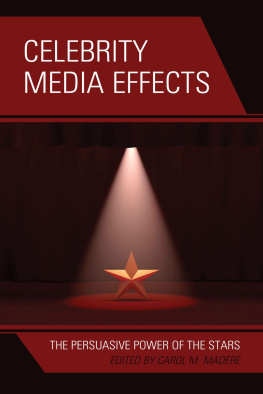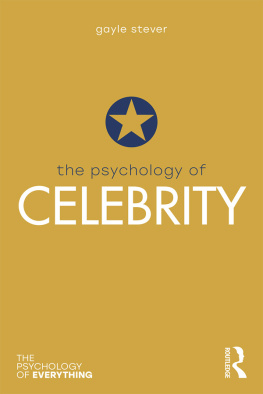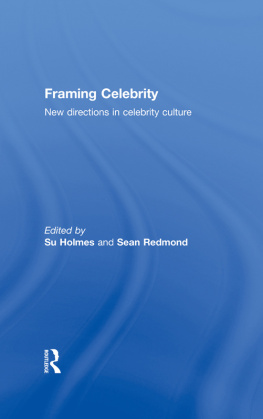Contents
Guide
Pagebreaks of the print version
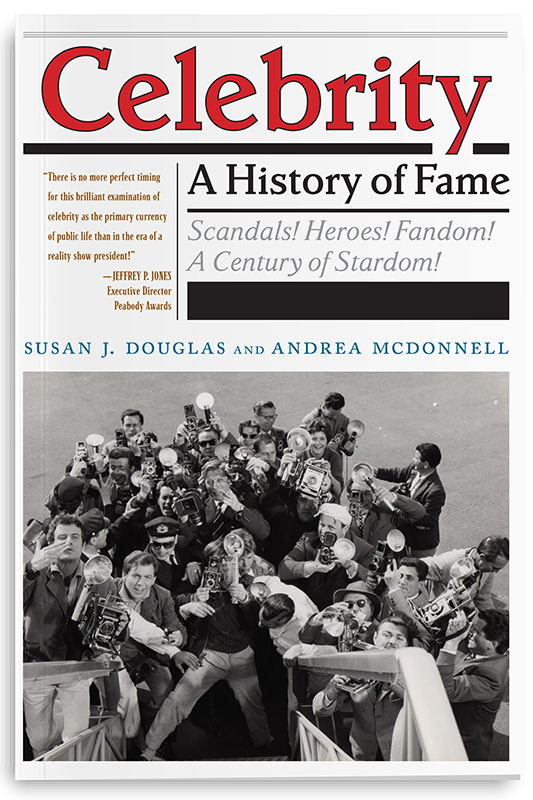
CELEBRITY
CRITICAL CULTURAL COMMUNICATION
General Editors: Jonathan Gray, Aswin Punathambekar, Adrienne Shaw
Founding Editors: Sarah Banet-Weiser and Kent A. Ono
Dangerous Curves: Latina Bodies in the Media
Isabel Molina-Guzmn
The Net Effect: Romanticism, Capitalism, and the Internet
Thomas Streeter
Our Biometric Future: Facial Recognition Technology and the Culture of Surveillance
Kelly A. Gates
Critical Rhetorics of Race
Edited by Michael G. Lacy and Kent A. Ono
Circuits of Visibility: Gender and Transnational Media Cultures
Edited by Radha S. Hegde
Commodity Activism: Cultural Resistance in Neoliberal Times
Edited by Roopali Mukherjee and Sarah Banet-Weiser
Arabs and Muslims in the Media: Race and Representation after 9/11
Evelyn Alsultany
Visualizing Atrocity: Arendt, Evil, and the Optics of Thoughtlessness
Valerie Hartouni
The Makeover: Reality Television and Reflexive Audiences
Katherine Sender
Authentic: The Politics of Ambivalence in a Brand Culture
Sarah Banet-Weiser
Technomobility in China: Young Migrant Women and Mobile Phones
Cara Wallis
Love and Money: Queers, Class, and Cultural Production
Lisa Henderson
Cached: Decoding the Internet in Global Popular Culture
Stephanie Ricker Schulte
Black Television Travels: African American Media around the Globe
Timothy Havens
Citizenship Excess: Latino/as, Media, and the Nation
Hector Amaya
Feeling Mediated: A History of Media Technology and Emotion in America
Brenton J. Malin
The Post-Racial Mystique: Media and Race in the Twenty-First Century
Catherine R. Squires
Making Media Work: Cultures of Management in the Entertainment Industries
Edited by Derek Johnson, Derek Kompare, and Avi Santo
Sounds of Belonging: U.S. Spanish-Language Radio and Public Advocacy
Dolores Ins Casillas
Orienting Hollywood: A Century of Film Culture between Los Angeles and Bombay
Nitin Govil
Asian American Media Activism: Fighting for Cultural Citizenship
Lori Kido Lopez
Struggling for Ordinary: Media and Transgender Belonging in Everyday Life
Andre Cavalcante
Wife, Inc.: The Business of Marriage in the Twenty-First Century
Suzanne Leonard
Dot-Com Design: The Rise of a Useable, Social, Commercial Web
Megan Sapnar Ankerson
Postracial Resistance: Black Women, Media, and the Uses of Strategic Ambiguity
Ralina L. Joseph
Netflix Nations: The Geography of Digital Distribution
Ramon Lobato
The Identity Trade: Selling Privacy and Reputation Online
Nora A. Draper
Celebrity: A History of Fame
Susan J. Douglas and Andrea McDonnell
Celebrity
A History of Fame
Susan J. Douglas and Andrea McDonnell

NEW YORK UNIVERSITY PRESS
New York
NEW YORK UNIVERSITY PRESS
New York
www.nyupress.org
2019 by New York University
All rights reserved
References to Internet websites (URLs) were accurate at the time of writing. Neither the author nor New York University Press is responsible for URLs that may have expired or changed since the manuscript was prepared.
Library of Congress Cataloging-in-Publication Data
Names: Douglas, Susan J. (Susan Jeanne), 1950 author. | McDonnell, Andrea M., author.
Title: Celebrity : a history of fame / Susan J. Douglas and Andrea McDonnell.
Description: New York : New York University Press, [2019] | Includes bibliographical references and index.
Identifiers: LCCN 2018030568| ISBN 9781479852437 (cl : alk. paper) | ISBN 9781479862030 (pb : alk. paper)
Subjects: LCSH: Celebrities. | Fame. | Social influence. | Social status. | Mass mediaSocial aspects. | Popular culture.
Classification: LCC HM 1176 . D 68 2019 | DDC 302/.13dc23
LC record available at https://lccn.loc.gov/2018030568
New York University Press books are printed on acid-free paper, and their binding materials are chosen for strength and durability. We strive to use environmentally responsible suppliers and materials to the greatest extent possible in publishing our books.
Manufactured in the United States of America
10 9 8 7 6 5 4 3 2 1
Also available as an ebook
For Paddy Scannell, teacher, scholar, mentor, friend
CONTENTS
Introduction
In the twenty-first century, celebrity culture and celebrity journalism are everywhere: they are inescapable fixtures in our media landscape and our everyday lives. Celebrity culture has become a central, dominant, and structuring force in American life, leading some to note that our society has become celebritized or celebrified. Whether youre standing in the checkout line at the supermarket or drugstore, checking your Facebook, Instagram, Snapchat, or Twitter feed, or, of course, simply turning on your TV, celebritiesthe stories they tell, the stories about thembombard us from every media outlet. The famous face is ubiquitous, it seems to spring up in every direction, an undeniable presence that surrounds and consumes us, as we consume it. While this is a revolution especially of the past twenty-five years, its origins go much farther back. This book provides an overview of that revolution, its repressed history, the underestimated cultural work it has done, its consequences, and especially the role that new communications technologies have played in enabling it.
Yes, of course, from Mary Pickford to Bette Davis to Marilyn Monroe, stars claimed the center stage of American life in the twentieth century. But in 1980, only 19.9 percent of homes had cable TV (and most cable companies only offered up to twelve channels), the celebrity magazines had not yet gone through their rapid, multiple mitoses, there was no reality TV that instantly manufactured stars, there were not yet celebrity chefs and celebrity chief executive officers, and there was no Internet or social media. Now we have all these. Thus, the status of celebrity culture and gossip has changed dramatically, especially since the early twenty-first century. Celebrity culture and gossip, except for truly major, high-profile romances or divorces (like those between superstars Elizabeth Taylor and Richard Burton in the 1960s and 70s), were seen as down-market, trashy, irrelevant fare that educated or respectable middle-class people should avoid. But today these are impossible to avoid and, more importantly, knowing about celebritiesat least some of them anywayis now an often necessary part of ones cultural arsenal of knowledge. The tone has changed as well, especially with the multiplication of gossip magazines, blogs, and social media in the twenty-first century and their delight in scandal and often the derision of celebrities as well as the opportunity for us to feel closer to and even interact with those who are well known. What is the significance of all this, for us, and our society?
Celebrity culture today consists of four major building blocks: the celebrity, of course, the media, the public, and the celebrity production industry, which consists of managers, agents, promoters, and some elements of the media, from gossip magazines to Instagram. Celebrity itself has typically involved four elements: a person, some kind of achievement, subsequent publicity, and then what posterity has thought about them ever since. Thus celebrity can be, of course, fleeting and banal: todays star could easily be tomorrows has-been. But the fact of celebrity culture, its permanence and growth, the industry that supports it, the huge profits it generates, the distractions it providesand promotesthese are no longer trivial. Celebrity gossip and culture used to be confined to fan magazines, a few tabloids, and certain TV talk shows. Now, celebrities and stories about them are everywhere, in the nightly news and in politics, on the covers of womens and public affairs magazines, on reality TV shows and multiple, proliferating TV talk shows, and especially on our smartphones. Indeed, the countrys forty-fifth president was a former reality TV show star, who converted his status as a celebrity into political power. When what used to be more on the margins of the media becomes absolutely central to it, and thus to our culture, we need to understand how and why, and what the implications are for our society and for us as individuals.



